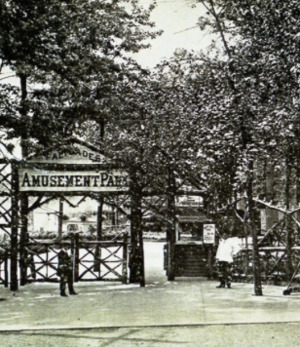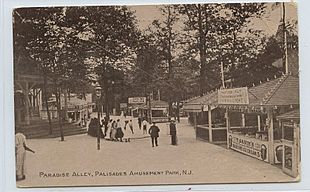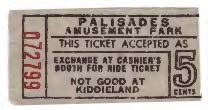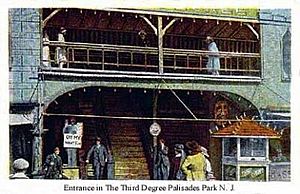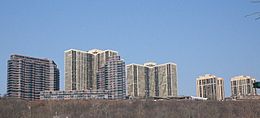Palisades Amusement Park facts for kids
| Previously known as Park on the Palisades, Schenck Brothers Palisade Park | |
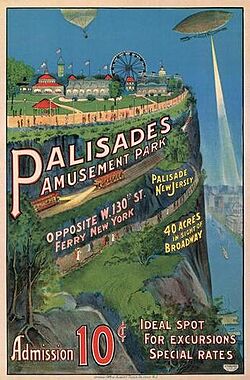 |
|
| Location | Cliffside Park-Fort Lee, New Jersey, U.S. |
|---|---|
| Coordinates | 40°49′41″N 73°58′40″W / 40.8281°N 73.9778°W |
| Status | Closed |
| Opened | 1898 |
| Closed | September 12, 1971 |
| Owner | Nicholas and Joseph Schenck, Jack and Irving Rosenthal |
| Slogan | Come on over! |
| Operating season | Weekend before Easter to Sunday after Labor Day |
| Area | New York metropolitan area |
| Attractions | |
| Total | 45-50 (rides varied from season to season) |
| Roller coasters | 5 |
Palisades Amusement Park was a super popular amusement park located in Bergen County, New Jersey. It sat high up on the New Jersey Palisades, right across the Hudson River from New York City. The park was partly in Cliffside Park and partly in Fort Lee. It was open from 1898 until 1971. For many years, it was one of the most visited amusement parks in the whole country! After it closed, fancy apartment buildings were built where the park used to be.
Contents
Early Days: A Trolley Park (1898-1910)
The park started way back in 1898. Back then, not many people had cars. So, a company called Bergen County Traction Company created the park. They wanted to encourage people to ride their trolley cars on evenings and weekends. This is why it was called a "trolley park." It was first known as "The Park on the Palisades."
The park was built on 30 acres of land overlooking the Hudson River. In 1908, the trolley company sold the park to August Neumann and Frank Knox. They added fun attractions like a Ferris wheel and even diving horses!
New Owners, New Rides (1910-1934)
Around 1908, the park got its famous name: Palisades Amusement Park. In 1910, two brothers, Nicholas and Joseph Schenck, bought the park. They were also involved in the early movie business. They changed the park's name again to Schenck Bros. Palisade Park.
In 1912, a huge salt-water swimming pool was added. It was filled with water pumped from the Hudson River, which is 200 feet below! This pool was 400 by 600 feet. It was advertised as the biggest salt-water wave pool in the country. Big pontoons under the water made waves, making it feel like the ocean.
The park became super famous in the 1920s. It was so well-known that a nearby town, Palisades Park, even thought about changing its name to avoid confusion! In 1928, the park got a thrilling roller coaster called the Cyclone. It was one of three very intense coasters built by Harry Traver. However, it was very expensive to keep running, so it was removed after only six years.
The Rosenthal Era: Big Popularity (1934-1971)
In 1934 or 1935, the Schenck brothers sold the park to Jack and Irving Rosenthal. These brothers were smart business owners who had made a lot of money with attractions at Coney Island in Brooklyn. They also owned the famous Coney Island Cyclone roller coaster.
The park faced some challenges. It was partly damaged by fire in 1935. Another fire in 1944 made the park close until the 1945 season. The Rosenthals changed the park's name back to the well-known Palisades Amusement Park. They rebuilt and improved many rides, including the Skyrocket roller coaster, which they renamed the "Cyclone." In 1958, they added another fun ride called the Wild Mouse roller coaster.
The park's fame grew a lot in the 1950s and 1960s. This was partly because of lots of advertising. They also had popular rock and roll shows and Motown music acts. You might have even seen their ads in old comic books! The Rosenthals knew that many young people in the New York metropolitan area read comic books, so it was a great way to reach future visitors.
Fair Access for Everyone
In 1946, the park created a "Sun and Surf Club" for its pool. However, this club was used to unfairly stop people of color from using the pool. For example, in July 1946, white people were allowed to buy tickets, but black people with them were not.
Because of this, African Americans and their supporters began protesting. They held signs saying "Protest Jim Crow" (which were unfair laws that allowed segregation). In July 1947, a young African-American woman named Melba Valle was not allowed into the pool. She was even "forcibly dragged and ejected" from the park.
This led to more protests by the Congress of Racial Equality (CORE). They protested at the park entrance every Sunday. They said they would not stop until the pool allowed African Americans to enter.
Here is a flyer from 1947 that protesters handed out:
DON'T GET COOL
AT PALISADES POOL
Palisades Pool, against New Jersey Civil Rights Law, stops Black people and those with dark skins from entering.
They are told a club exists, and only members can use the pool.
But white people who are not "members" are let in regularly and given a "membership" card inside.Irving Rosenthal, the Park's owner, refused to stop this unfair treatment, even though it breaks New Jersey law.
Members of our mixed group who tried peacefully to get into the pool
were roughly handled by the Park's private guards and by Fort Lee police.On July 27, a Black person was hit from behind by a park worker
while other park "goons" pushed him onto a bus.On August 3, eleven CORE members were arrested on false charges, and two were beaten by the police.
Thankfully, by the 1950s, the park changed its policy and allowed everyone to use the pool.
"Palisades Park" Song and Huge Crowds
In 1962, a song called "Palisades Park" became a big hit! Chuck Barris wrote it, and Freddy Cannon sang it. The song was a fast rock and roll tune with cool organ music and amusement park sounds. This song played on radios everywhere and made the park even more famous. It brought a huge wave of new visitors!
There was a small hole in the fence behind the park's music stage. Local kids would use it to sneak into the park without paying. The Rosenthal brothers knew about it but never fixed it! Unlike some modern parks that charge to enter, Palisades Amusement Park charged for each ride. Irving Rosenthal, who loved kids, thought that if kids got in for free, they would spend their money on rides instead. He even printed free-admission offers on matchbooks!
Parking was also free. But as the park got more and more visitors, the parking lot often filled up. They opened an extra parking lot at the bottom of the cliff in Edgewater. Shuttle buses would take people up to the park. Sometimes, even this lot filled up, and people had to park on local streets far away. This caused traffic and made local residents unhappy.
From 1947 to 1971, Palisades Park had about 6 million visitors each year. In 1969, it reached its peak with 10 million visitors! Radio and TV ads in the New York area always told people, "Come on over!" And they certainly did!
The Park's Closing
Three main things led to Palisades Amusement Park closing down. First, there wasn't enough parking. Second, people weren't sure what would happen to the park in the future. Third, there were more accidents where visitors got hurt or even died.
By 1967, Jack Rosenthal had passed away, leaving Irving as the only owner. Irving was in his 70s, and it wasn't clear who would take over the park. Meanwhile, the park was so popular that the nearby towns of Cliffside Park and Fort Lee had terrible traffic jams and litter because of all the visitors.
Local residents were upset about the traffic, trash, and changes in their neighborhoods. They asked their local leaders to do something. Also, developers wanted to build tall buildings on the Palisades because of the amazing view of Manhattan. They pushed the local government to change the zoning rules for the park's land. This allowed them to build high-rise apartments there.
Many builders offered Irving Rosenthal a lot of money for the land. But he loved the park and tried to keep it open as long as possible. He refused to sell for a while.
Finally, in January 1971, a company from Texas bought the property for $12.5 million. They agreed to let Irving Rosenthal run the park for one last season. Palisades Amusement Park closed forever on Sunday, September 12, 1971. The very last person to swim in the famous "world's largest outdoor saltwater pool" was Curt Kellinger, whose father was the park's pool manager.
After it closed, some people tried to reopen the park for another season, but the town wouldn't give them a business license. So, the park buildings were torn down. The rides were sold, taken apart, and moved to other amusement parks in the United States and Canada. The towns thought about using the salt-water swimming pool, but it had been damaged too much by vandals.
Today, four tall, fancy apartment buildings stand where the park used to be. In 1998, on the 100th anniversary of the park's opening, a monument was built on the property. It's a small park called "The Little Park of Memories," with the names of the old rides carved into its bricks. In 2014, five original roller coaster cars from the Cyclone ride, which had been stored away for decades, were brought back to Bergen County. They are being restored and will be put on display for everyone to see!
Images for kids


